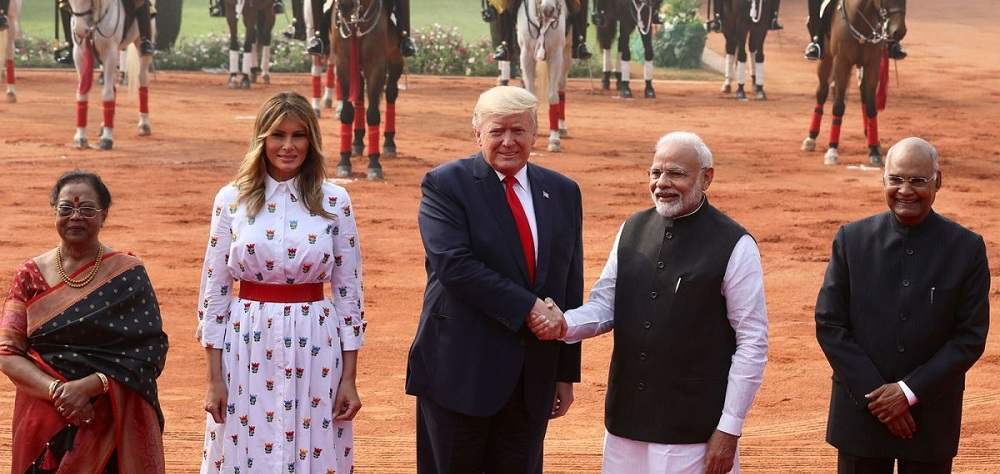Alwaght- The US President Donald Trump arrived in India on Tuesday, a few months after Prime Minister Narendra Modi of India visited the US. The visit appears to be a reciprocation of the PM Modi’s trip to Washington.
But just unlike his predecessors who flew directly to the capital New Delhi, Trump traveled to Ahmedabad, a city in Western India. The two sides declined to explain why the American president chose Ahmedabad. The city is the birthplace of right-wing Indian PM and he arranged for Trump a special reception ceremony there.
The trip, however, is not just to respond to Modi’s trip in late September to New York for meeting Trump. The mercantilist-minded US president follows a set of other goals behind the visit.
A history of Indian closeness to the US
The new chapter of the American-Indian relations was at the time of President Bill Clinton in the 1990s. When Clinton visited New Delhi in early 2000, the public imagination in India was that in case of alliance with the US the country will experience a new chapter of growth and development marked by further prosperity. It has been 20 years since the visit but India has failed to show signs of a fully developed country, though it is among the top 20 industrial nations.
When in July 2005, a nuclear cooperation pact was signed between the two sides, it left no doubt that India in South Asia has become a spot of the US policy focus, occupying a place larger than ever in the US foreign policy.
India, US’s bulwark in the face China
It should be taken into account that in the US strategists’ eyes expanded relations with India represent part of the doctrine to stop a thriving China. After all, the Americans know that in the process of the rise of new powerhouses in Asia, China is a leader and challenges the US interests.
Responding to this reality, the US by broadening the ties with India adds a new aspect to its strategy of trying to stop the Chinese emerging hegemony in Asia. The US policy revolves around aiding economic and military growth of Washington-aligned powerhouses whose set aim is containing China’s power and domination in the region.
The Indian participation in the novel Asian balance should be read within this strategy. The strategic circles in the US recommend that New Delhi take more serious steps to stop the Chinese regional influence. The US, Australia, Japan, and India square alliance is established for this purpose. By traveling to India, Trump seeks to reinforce the ties between the two sides of this square.
Big India market amid US-provoked trade tensions
At the same time, the considerable Indian economic developments over the past years should not be underestimated, making Trump look at the country as a big and firsthand market for American goods. That makes growth of American-Indian ties of significance. With a $128 billion trade volume with India in 2018, the US has been one of the top Indian trade partners.
But their trade tensions have overshadowed the Trump trip. India is one of the biggest strategic allies of the US in Asia but a major trade deal during the visit is unlikely as their relations over the past two years have been hit by trade tensions as the two follow a policy of economic protectionism.
In fact, despite their heightened political and strategic relations, Washington and New Delhi could not avoid some trade tensions over the past two years. In September last year, President Trump said India’s tariffs – taxes on imports – are “unacceptable,” and described India as the “king” of tariffs.
The US in June ended preferential trade status for India. The special status is a specific program allowing goods to enter the US tariff-free. This drew reactions from New Delhi which imposed tariffs on 28 American goods imported to India, stirring tensions with Washington. Now the two sides’ leaders hope that the visit will repair their ties that were frayed over the exchanged tariffs.
But it is not only the trade that has sent Trump to India. The US had a long-term plan to sell weapons to India. The two sides sign an over $3 billion arms deal during bilateral talks.
Earlier, India signed a pact with Moscow to buy Russian S-400 air defense systems. Now Trump is pushing for India to review its arms cooperation with Russia. Possibly, Trump’s discontentment with the Indian-Russian arms deal would be part of the American-Indian talks.
Personal use of India trip
Moreover, the trip to India is significant to Trump because it is made as the US presidential elections near. Trump is struggling to attract Indian-American large groups who have a big influence in the US.
While onboard Air Force One, Trump in a Twitter message in Hindi said: “We look forward to coming to India. We are on the way. We will meet everyone in a few hours.” The Hindi-language tweet shows that Trump banks on the Indian-Americans for support. By this trip, he wants to get their backing in November presidential race.
This visit is important for Trump in the election year, mainly because the Indian migrants to the US who majorly come from Gujarat are wealthy and influential. Many of them advocated Trump in his election campaign and experts believe that the visit was paid to maintain their support to Trump in the face of Democratic rival.



























